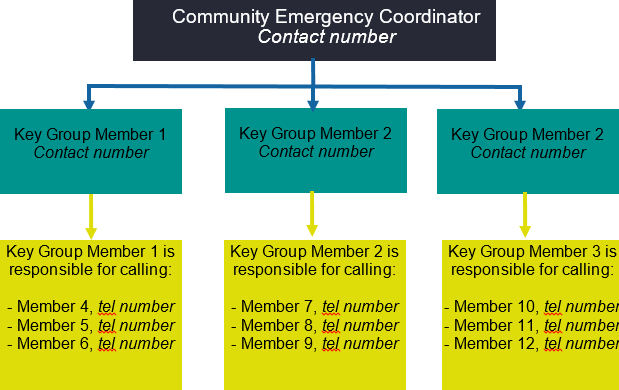The following templates are a suggestion only and should be adapted to suit your group’s needs. Please feel free to use, change or add different information as you see fit

Community Emergency Plan
Plan last updated on: xx/xx/xxxx
IF YOU ARE IN IMMEDIATE DANGER CALL 999
Plan distribution list
|
Name |
Role |
Phone number/email address |
Issued on |
|
Enter Name |
Enter Role |
Enter Details |
Enter Date |
|
|
Example: |
|
|
|
|
Local Authority Resilience Officer |
|
|
|
|
Community Council Representative |
|
|
|
|
SFRS community safety representative |
|
|
|
|
Local Resilience Forum Rep |
|
|
|
|
Key networks or groups in your local area such as a local school, parent council, church or other faith group etc |
|
|
|
|
|
|
|
Amendments to Plan
|
Name |
Details of changes made |
Changed by |
Date for next revision |
|
Enter Name |
Enter Details |
Enter Details |
Enter Date |
|
|
|
|
|
|
|
|
|
|
|
|
|
|
|
|
|
|
|
|
|
|
|
|
|
LOCAL RISK ASSESSMENT
|
Risks – including likelihood |
Impact on community/ Vulnerability |
What can Community Emergency Group do to prepare? |
|
Example: River through village can flood – every 2-3 years. |
Example: Flooding of local streets Example: Blocked access to community hall Example: Damage to homes |
Example: Encourage residents to improve home flood defences Example: Work with local emergency responders to see if can help with distribution of flood warnings and any evacuation and rest centre establishment required Example: Identify vulnerable people who live in areas likely to be flooded |
|
|
|
|
|
|
|
|
|
|
|
|
|
|
|
|
LOCAL SKILLS AND RESOURCES ASSESSMENT
|
Skill/resource |
Name |
Contact details |
Location |
|
Example: Trained first aider |
Example: Mr A. Sample |
Example: 0131 123 4567 |
Example: 1 Sample Street, Sampletown, SA1 2PL |
|
|
|
|
|
|
|
|
|
|
|
|
|
|
|
|
|
|
|
|
|
|
|
|
|
|
|
|
|
|
|
|
|
|
|
KEY LOCATIONS
identified and agreed with local authority for use as places of safety
|
Building |
Location |
Potential usage in an emergency |
Contact details |
|
Example: Church Hall |
Example: Sampleton Village |
Example: Rest Centre/safe place |
Example: Church warden’s contact number |
|
|
|
|
|
|
|
|
|
|
EMERGENCY CONTACT LIST
|
Photo |
Name: Enter Name |
| Title: Enter Job Title | |
| 24hr telephone contact: Enter Number | |
| Email: Enter Email | |
|
Address: Enter Details |
|
|
Photo |
Name: Enter Name |
| Title: Enter Job Title | |
| 24hr telephone contact: Enter Number | |
| Email: Enter Email | |
|
Address: Enter Details |
SAMPLE TELEPHONE TREE
The phone tree works as a pyramid. The coordinator at the top makes the first call to two or more people. In turn, they call an assigned set of people and so on, until the tree is complete, for example:

Remember to record both mobile and landline numbers if available.
LIST OF COMMUNITY ORGANISATIONS
that may work with people who may become vulnerable in people or communities in an emergency
[Use this space to record details of organisations who work with people who may be vulnerable in an emergency]
ACTIVATION TRIGGERS
[Use this space to record details of how your Plan will be activated as a result of a call from the emergency responders, and also how your community will decide to activate the Plan if the emergency responders are unavailable]
FIRST STEPS IN AN EMERGENCY
Follow the instructions below when the Plan is activated.
|
|
Instructions |
Tick |
|
1 |
Example: Call 999 (unless already alerted) |
✓ |
|
2 |
Example: Ensure you are in no immediate danger |
✓ |
|
3 |
Example: Contact the Community Emergency Group and meet to discuss the situation |
✓ |
|
4 |
|
|
|
5 |
|
|
|
6 |
|
|
|
7 |
|
|
|
8 |
|
|
|
9 |
|
|
|
10 |
|
|
COMMUNITY EMERGENCY GROUP MEETING AGENDA
Agenda Date: Enter Date
Time: Enter Time
Location: Enter Details
Attendees: Enter Details
1. What is the current situation?
Enter Details
You might want to consider the following:
Location of the emergency. Is it near:
- A school?
- A vulnerable area?
- A main access route?
Type of emergency:
- Is there a threat to life?
- Has electricity, gas or water been affected?
Are there any vulnerable people involved?
- Elderly
- Families with children
- Non-English-speaking people. What resources do we need? Food?
- Off-road vehicles? Blankets? Shelter?
2. Establishing contact with the emergency responders
Enter Details
3. How can we support the emergency responders?
Enter Details
4. What actions can safely be taken?
Enter Details
5. Who is going to take the lead for the agreed actions?
Enter Details
6. Any other issues?
Enter Details
ACTIONS AGREED WITH LOCAL AUTHORITY IN THE EVENT OF AN EVACUATION
[Use this space to record details of the actions you can take to help your local authority if an evacuation is necessary in your community.]
ALTERNATIVE ARRANGEMENTS FOR STAYING IN CONTACT IF USUAL COMMUNICATIONS HAVE BEEN DISRUPTED
You should have a range of communications methods to keep in touch with members of the group and members of your wider community, for example a telephone tree with both landline and mobile phone numbers and social media tools such as a Facebook Group or Community page or a WhatsApp Group.
However, if those usual methods of communications have been disrupted, then please use this space to record details of alternative communications.
This could be anything from a community notice board, to including the owner/locations of long distance walkie-talkies or details of your local Radio Amateurs’ Emergency Network (RAYNET) group, or other radio amateurs in your community.
Household Emergency Plan
If an emergency happens it may be some time before help arrives. It’s very important that you and your family get together to prepare.
- Agree a plan in advance with those in your home.
- Complete this template together and keep it safe in case you need to use it.
If the emergency means it is not safe to go out, the advice is usually to:
GO IN (go indoors and close all windows and doors),
STAY IN (stay indoors),
TUNE IN (to local radio, TV or the internet, where public information and advice from the emergency responders will be broadcast.)
My Local Radio station:
Frequency:
If you have to leave your home, get out, stay out, and take others with you.
Think of two meeting places: one near home and one further away, in case you can’t get home.
|
Meeting Place 1 (near home)
Location ………………….…...............
|
Meeting Place 2 (further away)
Location ………………….…...............
|
Pick a friend or relative who lives out of the area, who you will agree to call to say you’re OK, should you need to leave home. Make sure this person knows.
Friends’ name and numbers: …………………………………………….……………
If it is safe to do so you should check on your neighbours and vulnerable people living close by. Have a think about who they are in advance.
|
Important Numbers
Emergency services, 999 Non-Emergency, 101 NHS 24, 111 Floodline Scotland, 0345 988 1188 Loss of power, 105 Gas emergencies, 0800 111 999 Scottish Water, 0800 077 8778
|
Your Numbers
Schools/Colleges:….…………………….…… Carer/Childminder: …………………………... Work: ………………………………………….. Doctor: ………………………………………… Insurance: …………………………………….. Local authority:……………………………….. Vet: …………………………………………….
|
Other numbers & Information:
Pack an Emergency Kit
You should keep enough food and water and other essentials at home for at least three days.
Whether you have to stay in or get out, packing a small emergency kit will help you get through. Keep it in a safe place at home where you can reach it easily. Your kit should be kept in a waterproof bag and the top ten things to include are:
- Radio with spare batteries, or a wind up radio
- Torch with spare batteries, or a wind-up torch
- First aid kit
- Important documents like birth certificates and insurance policies
- Bottled water and ready-to-eat food that won’t go off. Pack a can opener if needed
- Spare keys to your home and car
- Spare glasses or contact lenses
- Toiletries and details of important medicines
- Pencil and paper, penknife, whistle
- Pet supplies
Always prioritise PEOPLE OVER POSSESSIONS. However, if you have to leave your home, and there’s time to gather them safely, you could also think about taking:
- Essential medicines
- Pets
- Mobile phone and charger
- Cash and credit cards
- Spare clothes and blankets
- Games, books, a child's special toy
- What else is important to you and your family?
Find out how to turn off your gas, electricity and water supplies to your home.
You could also consider moving (and securing) important possessions to the upper levels of your home or to higher ground if you are at risk of flooding e.g. your essential documentation, photos, jewelry medicines, or your vehicles.
For further advice on being prepared for emergencies see
www.ready.scot
© Crown copyright 2020
You may re-use this information (excluding logos and images) free of charge in any format or medium, under the terms of the Open Government Licence. To view this licence, visit http://www.nationalarchives.gov.uk/doc/open-government-licence/ or e-mail: psi@nationalarchives.gsi.gov.uk.
Where we have identified any third party copyright information you will need to obtain permission from the copyright holders concerned.
The Scottish Government St Andrew’s House Edinburgh, EH1 3DG


